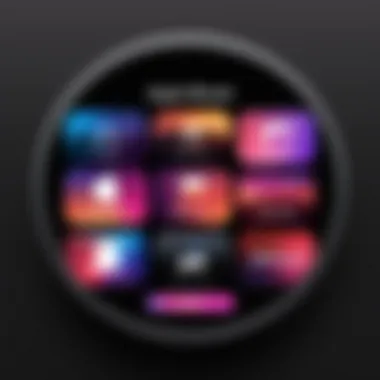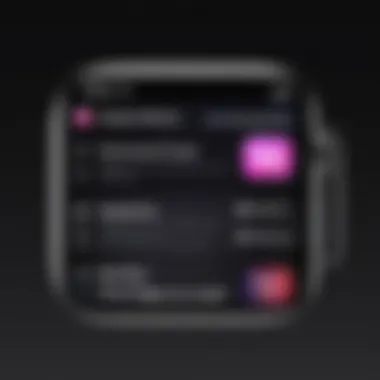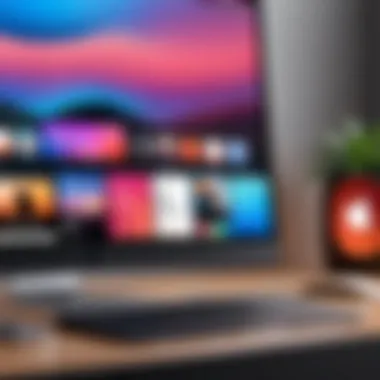Creating an Apple Music Widget: A Comprehensive Guide


Intro
In today's digital age, the significance of personalized user experiences cannot be overstated. With numerous applications available, users seek ways to customize their devices to reflect their preferences. One such significant customization option is the creation of widgets. Apple Music, a leading music streaming service, allows users to enhance their interaction through widgets.
This guide provides a thorough understanding of how to create an Apple Music widget. Whether you are a beginner or an experienced user looking to optimize your interface, this article encompasses the essential tools, steps, and customization options to consider. Understanding how to implement an Apple Music widget could greatly enrich your listening experience.
Product Overview
Creating a widget is an opportunity to streamline access to your favorite music. Apple Music provides features that can be showcased in a widget, allowing for quick interaction and a visually appealing interface. The following key features and specifications should be noted:
Key Features
- Ease of Access: The widget allows quick access to playlists, favorites, and recently played songs.
- Customization Options: Users can adjust the widget’s appearance according to their preferences, such as colors and sizes.
- Compatibility: The widget is compatible with various devices, including iPhones, iPads, and Mac computers.
- Real-Time Updates: Users benefit from real-time updates to song lists, keeping access fresh and current.
Specifications
- Operating System: Requires iOS 14 and above or macOS Big Sur and higher for optimal functionality.
- Size Options: Available in different sizes (small, medium, and large) to fit various displays.
- Network Requirement: Continuous Wi-Fi or cellular connection is required for streaming capabilities.
The ability to customize widgets not only enhances personal style but also increases efficiency. A well-placed and designed widget can make a significant difference in user experience.
Performance Analysis
Evaluating the performance of the Apple Music widget involves looking at its speed, efficiency, and overall user impact.
Speed and Efficiency
In real-world usage, the widget reacts swiftly when users interact with it. Opening a playlist or playing a song typically takes mere seconds, combining both efficiency and user satisfaction. Minimal load times contribute to a seamless experience.
Battery Life
The widget employs optimization techniques to limit excessive battery consumption, ensuring it operates without significantly impacting device battery life. Apple continually works on software updates and optimizations that enhance power management for applications, including widgets.
Prelude to Apple Music Widgets
In the evolving landscape of digital music consumption, Apple Music widgets play a significant role. They enhance user interactivity and offer personalized experiences that align with how users consume digital music. Understanding how to create and utilize these widgets can transform ordinary playlists into dynamic displays on your device's home screen. This guide serves to illuminate the importance of these widgets, focusing on their myriad benefits and the considerations involved in their implementation.
Understanding Widgets
Widgets, at their core, are interactive elements that allow users to access content and functionalities in real time without navigating through full applications. They are often employed to deliver concise information quickly. In the context of Apple Music, a widget can provide real-time updates on your favorite tracks, suggest playlists, and streamline the playback process. By integrating a widget directly into your device’s interface, you reduce the number of steps required to access your music.
Widgets can vary in size and appearance, allowing users to tailor their experience. For instance, a small widget may show the currently playing song, while a larger version could showcase recent playlists or album covers.
Here are some key aspects of Apple Music widgets:
- Real-Time Updates: Instant access to your currently playing songs and recommended playlists.
- User Interaction: Allows for quick playback control, enhancing user experience.
- Visual Appeal: Customizable aesthetics that align with personal style preferences.
The Role of Apple Music in Digital Consumption
Apple Music has established itself as a leading player in the digital music industry. With millions of tracks available, it caters to a diverse audience. In this digital era, where instant access to music is expected, the role of Apple Music extends beyond mere listening. It has become a platform for discovery, engagement, and personalization.
The emergence of widgets aligns perfectly with the current consumption habits of users. Users favor quick access to content over navigating through multiple menus. As such, Apple Music widgets ensure that users can engage with their favorite tracks, albums, and playlists with minimal friction.
Benefits of Apple Music in today's digital landscape include:
- Curated Content: Personalized playlists based on listening habits.
- Social Connectivity: Options to share music and collaborate with friends.
- High-Quality Audio: Access to lossless audio and Spatial Audio features, enhancing listening experience.
"Widgets transform the way we interact with music, fostering a continuous relationship with our favorite sounds and artists."


This exploration of Apple Music widgets will provide you the insights needed to enhance your digital music consumption. You will understand the technical requirements, step-by-step creation, and customization options for a seamless experience.
Requirements for Creating an Apple Music Widget
Understanding the requirements for creating an Apple Music widget is essential for anyone looking to enhance their user experience with Apple Music. This section will cover the necessary hardware and software components needed to effectively design, develop, and implement your widget. Being aware of these requirements helps you avoid compatibility issues and ensures a smoother process.
Compatible Devices
Creating an Apple Music widget requires specific devices that can support both the widget and the Apple Music app. The following are key device categories where you can successfully develop and run the widget:
- iPhone: Widgets are primarily designed for mobile devices, and the iPhone offers optimal functionality with its various screen sizes.
- iPad: The larger screen makes an iPad suitable for displaying more content, such as playlists and album art, in a visually appealing manner.
- Mac: Desktop widgets provide a different kind of interaction, allowing users to control music playback while engaging in other tasks.
- Apple Watch: Widgets on the watch can deliver quick access to favorite tracks and playlists, promoting seamless listening on the go.
Compatible devices maximize the widget's potential, ensuring users can access all features and functionality without limitations.
Software and Applications Needed
In addition to hardware, specific software is also required to create an Apple Music widget. Here are essential tools you should consider:
- Apple Music App: This fundamental application lets you access your music library and streaming services. It is crucial for the widget to pull content from.
- Widgetsmith or Widgy: These third-party applications allow customization of widgets, enabling users to configure different layouts and styles tailored to personal preferences.
- Xcode: For those with programming skills, Xcode provides an environment for developing more complex widgets that go beyond standard templates. This software is especially useful for developers who want to create unique user experiences.
- Latest iOS/macOS: Keeping your devices up to date ensures access to the latest features and fixes any bugs that could interfere with widget development.
By utilizing the right software and applications, the process of creating an Apple Music widget can be greatly streamlined. Awareness of these requirements ensures that users are well-prepared to take the next steps in building their custom music experience.
Step-by-Step Guide to Creating the Widget
Creating an Apple Music widget invites users into a realm where their favorite music and personal preferences converge seamlessly on their devices. This process not only enhances the user experience but also showcases a personalized touch that reflects one’s musical identity. A widget, in essence, acts as a mini-interface that gives quick access to Apple Music, making navigation more intuitive and aesthetically pleasing.
Accessing the Widget Creation Tool
To begin the widget creation journey, accessing the right tools is crucial. Apple provides an integrated development environment within their software suite, allowing users to create customized widgets tailored to individual preferences.
- Locate the Widget Settings: On your iOS device or Mac, find the Widget settings under the layout options or app management section.
- Select Widget Creation Tool: Tap or click on the option that allows you to create or customize widgets. This might involve navigating through menus that categorize features and functionalities.
- Install Necessary Applications: Ensure all the required applications, such as Shortcuts or the latest Apple Music update, are installed and current to avoid compatibility issues.
Having access to the widget creation tool sets the foundation for further customizations and integrations, ensuring that users can enjoy a rich experience with their music.
Configuring Widget Settings
Configuring widget settings is essential in refining the user experience. The settings provide various options that allow individuals to tailor the widget according to their preferences.
- Choosing Widget Size: Consider the available space on your home screen. You can select from sizes like small, medium, or large, depending on how prominent you want the widget to be.
- Adjusting Display Options: This involves determining which features from Apple Music will show up, such as recently played songs or favorite playlists. Fine-tuning these elements ensures users have quick access to what matters most to them.
- Selecting Themes and Layouts: Depending on the iOS version and customization options available, users may also adjust visual aesthetics to fit their device’s overall look.
Desiring a well-configured widget equips users with an interface that feels personalized and efficient.
Integrating Apple Music Features
Integrating Apple Music features into the widget takes your customization a step further, allowing the widget to truly reflect your music preferences and lifestyle.
- Link to Playlists: Users can directly link their favorite playlists, providing swift access whenever they need a musical uplift. This means having the ability to showcase tailored playlists without diving into the app repeatedly.
- Displaying Album Art: Featuring album covers creates a visual connection with the music. Having eye-catching images alongside the song titles is compelling and engages the users more effectively.
- Implementing Music Controls: Including controls for play, pause, and skip fosters an interactive element right from the widget. This capability reduces the friction of opening the application each time music needs adjusting.
Overall, integrating these features enhances functionality and encapsulates a personalized musical experience, making everyday interactions with the widget gratifying.
Customizing Your Apple Music Widget
Customizing your Apple Music widget is essential for creating a personalized user experience. This aspect allows you to tailor the widget to your aesthetic preferences and functional needs. A well-customized widget not only enhances the usability but also reflects your personal taste, making it an integral part of your interface with Apple Music.
When designing a widget, it is important to consider various elements such as size, display options, and the content you want to showcase. Each of these factors contributes to how effectively users can engage with the content. A suitable widget can simplify navigation and interaction with music tracks, encouraging more frequent use with Apple Music.


Choosing Widget Size and Display Options
The size and display options of your widget are crucial. The dimensions of the widget can affect how much information is visible to the user at a glance. For instance, larger widgets can accommodate more album cover art and song details, while smaller widgets tend to be more discreet upon the home screen.
When selecting the appropriate size, consider how you use Apple Music. Users who enjoy creating playlists or frequently switching between albums may find larger options more beneficial. In contrast, those with limited space on their screens can opt for more compact designs. Ensure to evaluate these display options:
- Widget sizes: Choose between small, medium, or large based on user needs.
- Layout options: Assess vertical versus horizontal presentation to suit the screen orientation.
- Text and icon visibility: Ensure that song titles and controls are legible.
Using these considerations, you can select an optimal size that enhances accessibility and engages users effectively.
Adding Album Art and Covers
Incorporating album art and covers into your widget adds visual appeal and context to your music. This feature does not only beautify the interface but also gives users a quicker way to recognize their favorite tracks or artists at a glance. Properly displayed album covers can influence a user’s choice more than text alone, engaging both sight and sound.
When adding album art, keep the following in mind:
- High-resolution images: Choose images that are clear and sharp to prevent pixelation.
- Aspect ratio: Ensure that the album art fits well within the widget's boundaries, maintaining a clean look.
- Dynamic images: Opt for settings that allow album art to update automatically as tracks change, creating a fluid experience.
This customization makes the Apple Music widget not only functional but also visually engaging, appealing particularly to those who appreciate artistic presentation in their technology.
Setting Up Playlists and Favorites
Setting up playlists and marking favorites in your widget is a practical approach to personalize the user experience. By prioritizing certain tracks or albums, you can make navigation more intuitive. Users can easily access their most listened-to music without hassle.
To enhance usability, follow these guidelines:
- Playlist selection: Integrate your most frequently played or curated playlists directly into the widget.
- Favoriting options: Allow users to mark tracks as favorites for quick access without searching lengthy playlists.
- Regular updates: Encourage revision of playlists to keep content fresh and relevant to user listening habits.
By focusing on these elements, the widget becomes a tailored music hub, enabling seamless access to preferred tracks and enhancing the overall experience with Apple Music.
With effective customization, the Apple Music widget serves as a dynamic companion for audiophiles and casual listeners alike.
Testing Your Apple Music Widget
Testing the Apple Music widget is essential in ensuring it operates smoothly and meets your expectations. This phase is critical after the development and customization processes. A well-functioning widget not only enhances the user experience but also reflects the overall quality of your integration with Apple Music. Therefore, by taking the time to effectively test your widget, you minimize chances of future issues that could disrupt music enjoyment.
Verifying Functionality
Verifying functionality goes beyond just checking if your widget appears on the screen. This step involves testing several key features to confirm that everything works as it should. Start by ensuring that the widget displays the correct album art, playlists, and user favorites. Listen to music directly through the widget to confirm that each selection initiates playback without delay.
Check for interactions such as tapping on songs or playlists and ensure they respond correctly. You should also validate the refresh rates. If your widget is set to update music content at set intervals, see if it does so without glitches.
Finally, test the widget across different devices if applicable. There might be variations in functionality depending on the screen size or operating system. Achieving consistent performance across devices enhances usability for a broader audience.
Troubleshooting Common Issues
Common issues can arise during the testing phase, and knowing how to troubleshoot them is vital. Here are several potential problems and their solutions:
- Widget Not Displaying: If the widget fails to appear, ensure that you have the latest version of the necessary software installed. Sometimes, a simple restart of the device can restore the widget.
- Playback Failure: If songs do not play, double-check the connections to Apple Music. Ensure that your account is active and correctly linked to the widget.
- Incorrect Content Display: If the displayed playlists or songs do not match your selection, verify the settings in the widget configuration. Look for options to refresh the content source.
- Slow Response: If the widget responds slowly or erratically to commands, check for any updates or patches for the software that may improve performance.
Maintaining Your Apple Music Widget
Maintaining your Apple Music widget is essential for ensuring its continued functionality and relevance. A widget that reflects current content and settings can significantly enhance the user experience. Regular maintenance helps prevent technical issues, keeps the interface appealing, and ensures that users engage with the latest options offered by Apple Music. This section explores two key areas of widget maintenance: updating widget settings regularly and refreshing music content.
Updating Widget Settings Regularly


Keeping your widget settings updated is crucial. Technology evolves frequently, and Apple Music regularly introduces new features and improvements. By updating the settings of your widget, you can leverage these advancements to enrich your users' experience. Here are some key reasons for regular updates:
- Compatibility: Updates ensure that your widget remains compatible with the latest iOS versions and Apple Music features.
- User Engagement: Regularly updated settings can keep your widget dynamic and encourage users to return for fresh content.
- Feature Utilization: New settings may unlock previously unavailable features that can enhance usability.
To update the widget settings:
- Open the Widget Configuration Tool.
- Review the list of available settings.
- Adjust the settings as necessary to align with your preferences and the latest Apple Music features.
Refreshing Music Content
Another important aspect of maintaining your Apple Music widget is refreshing its music content. As listeners’ preferences change over time, ensuring that the widget showcases relevant music is vital for retaining user interest. Content refreshment not only keeps things current but also reflects the evolving nature of music trends. Some practical tips include:
- Automate Refreshing Content: Consider setting a schedule for automatic updates to pull in new playlists, albums, or songs from Apple Music.
- Personalize Playlists: Regularly update customized playlists based on listening habits. This personalization enhances user satisfaction.
"Ensuring freshness in your music content retains listener engagement and aligns the widget with user expectations."
Refreshing the content is straightforward. Access the music content settings within the widget configuration. Select new playlists or recent releases to display. By doing so, you maintain a connection with your audience, reflecting their current interests and enhancing their overall listening experience.
Best Practices for Widget Implementation
When creating an Apple Music widget, understanding effective strategies for implementation is essential. Best practices are not merely a set of guidelines; they are foundational strategies that enhance both functionality and user satisfaction. A well-designed widget can make the music experience more accessible and enjoyable, thereby encouraging users to engage more with Apple Music.
Optimizing for User Experience
User experience is a critical factor to consider when developing your widget. An intuitive interface will keep users coming back. To optimize user experience, focus on the following elements:
- Simplicity: The widget should present information in a straightforward manner. Avoid complex layouts that can confuse users.
- Accessibility: Ensure that all users can easily access the features of your widget. This includes accommodating those with visual impairments by using readable fonts and providing appropriate contrast.
- Responsive design: Make sure the widget adjusts well to different screen sizes and orientations. This aspect is crucial for maintaining functionality across devices like iPhones, iPads, and Macs.
Incorporating these aspects can lead to increased engagement and a more satisfying user interaction with the music platform.
Incorporating Feedback Mechanisms
Feedback mechanisms are vital for continuous improvement. Incorporating ways for users to provide input can guide you in modifying your widget effectively. Consider these tactics:
- Surveys and polls: Implement quick surveys within the widget to solicit opinions on specific features or overall satisfaction.
- In-app feedback forms: Allow users to report bugs or issues directly through the widget. This can facilitate timely resolutions and assure users that their concerns are valued.
- Analytics: Use analytics tools to track user behavior. Understanding how users interact with the widget can reveal areas for enhancement.
Regular feedback loops not only improve the widget but also foster a sense of community among users. They feel their voices matter, and this connection can enhance loyalty to the platform.
Each of these strategies supports the overarching goal of creating a user-centric experience. By prioritizing user engagement and modifying the widget based on real-world feedback, you can build a robust, effective tool.
Implementing these best practices will deepen your connection with users and foster a lasting relationship, ultimately maximizing the potential of the Apple Music widget.
Epilogue
The conclusion serves as a critical component in this article, encapsulating the insights on creating Apple Music widgets. Understanding the importance of this topic can significantly enhance a user's interaction with Apple Music. Custom widgets offer tailored experiences that cater to individual preferences, making it easier for users to access their favorite playlists and tracks.
Reviewing the Benefits of Custom Widgets
Custom widgets provide several advantages. First, they enhance accessibility by offering quick access to music without navigating through multiple applications. This streamlined approach saves time, allowing users to enjoy their music more efficiently.
Moreover, personalization plays a vital role. A custom widget can showcase specific playlists, albums, or even favorite tracks, creating a unique user experience. The visual appeal of a well-designed widget also adds to the aesthetics of a home screen, blending functionality with style.
Benefits also extend to improving engagement. Users are more likely to interact with their music library when it is easily accessible in a visually appealing format. A tailored Apple Music widget empowers users to curate their listening experience, reflecting their music tastes directly on their device's home screen.
Encouraging Ongoing Exploration of Features
The digital landscape is continuously evolving, and Apple Music is no exception. Encouraging ongoing exploration of its features can lead to discovering new ways to enjoy music. Users should regularly check for updates to both the Apple Music application and the widget itself. Features such as collaborative playlists and curated recommendations are evolving. Recognizing and utilizing these elements can enhance user satisfaction.
Furthermore, as technology advances, the capabilities of widgets are also expanding. Users should stay informed about new features that Apple may introduce. Engaging with communities, such as forums on Reddit, can be an excellent way to learn from others and gain tips on maximizing their widget's potential.
In summary, the importance of custom widgets in enhancing the Apple Music experience can not be understated. They offer personalized access to music, improve usability, and allow for ongoing exploration of features, ensuring that users get the most out of their digital music consumption.



